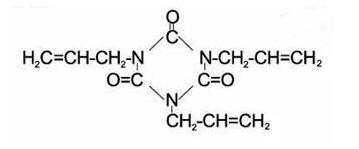Knowde Enhanced TDS
Identification & Functionality
- Plastics & Elastomers Functions
- CAS No.
- 1025-15-6
- Molecular formula
- C12H15O3N3
- EC No.
- 213-834-7
- Technologies
- Product Families
- Structural formula

Features & Benefits
- Materials Features
- Functions
- TAIC is available as cross-linked modifier for a variety of thermoplastic (polyethylene, polyvinyl chloride, chlorinated polyethylene, ethylene vinyl acetate (EVA), polystyrene, etc.). The amount is generally 1-3% by weight in peroxide cross-linking system, dicumyl peroxide (DCP) is 0.2 to 1% in addition; radiation cross-linking system 0.5 to 2% by weight. The cross-linked products can significantly improve heat resistance, flame resistance, solvent resistance, mechanical strength and electrical properties. It can significantly improve the product quality, and no odor compare with the peroxide cross-linking system. It is typical for polyethylene, polyethylene and chlorinated polyethylene, polyethylene and EVA, cross-linked polyethylene cables and other high or low-foam products.
- TAIC is available as co-vulcanizing agent for ethylene-propylene rubber, fluorine rubber, CPE and other special rubber (with DCP and the amount is 0.5 to 4% by weight), can significantly shorten the curing time,improve strength, abrasion resistance, insoluble, corrosion resistance.
- TAIC is available as cross-linking agent for acrylic, styrene-type ion exchange resin, has less usage, higher quality than di-vinylbenzene cross-linking agent, can prepare for ionic exchange resins with anti-pollution, high strength, large diameter, heat-resistance, acid and alkali resistance, excellent anti-oxidation properties. It is the newly developed and excellent prospective ion exchange resins.
- TAIC is used as modifiers for polyacrylate, polyethylene alkyl acrylate etc., can significantly improve heat resistance, optical properties and performance of process. It is typical for heat-resistant modification of polymethyl methacrylate glass.
- TAIC can be used as modifier as epoxy , DAP (Diallyl phthalate) and can improve the heat resistance, adhesion, mechanical strength and dimensional stability. It is typical for modification for epoxy potting material and encapsulation material.
- TAIC can be used as cross-linking agent and modifier for unsaturated polyester and thermoplastic polyester, it can significantly improve heat resistance, chemical resistance, dimensional stability, weather resistance and mechanical properties. It is typically used to improve heat resistance of the hot-press unsaturated polyester fiberglass, and using temperature of modified product can be above 180 ℃.
- The homo-polymer of TAIC (polytriallyl isocyanurate) can be used for bonding glass and ceramics because of its clear, hard, heat-resistant, excellent electrical insulation. It is typically used to manufacture multi-layer safety glass.
- TAIC can be used as inner plasticizer of polystyrene: Styrene copolymerization with TAIC, can obtain a transparent, anti-broken product.
- TAIC can be used as protecting agents for metal: pre-polymer of TAIC bakes on metal surface,and the coating has a very good heat resistance, radiation resistance, weather resistance and electrical insulation. It is typically used in insulating materials of manufacture of printed circuit boards and other microelectronic products.
- TAIC can be used as intermediates of photocurable paint, photo-resist, flame-retardant cross-linking agent; It is typically used in synthesis of high effective flame retardant TBC and DABC.
Applications & Uses
- Markets
- Applications
- Compatible Polymers & Resins
- Plastics & Elastomers End Uses
Properties
- Chemical Name
- Triallylisocyanurate
- Typical Properties
| Value | Units | Test Method / Conditions | |
| GC Content/Purity | min. 99.5 | % | — |
| Acid value | max. 0.2 | mg KOH/g | — |
| Freezing Point | 21.5-26.5 | — | — |
| Molecular Weight | 249.27 | — | — |
| Colour Intensity | max. 30 | APHA | — |
Packaging & Availability
- Packaging Type
- Package
Pack in iron drums or paper bags lined with PVC film bags; net weight: 200kg or 25kg;IBC drum 1000kg net weight.
Storage & Handling
- Storage
Store in cool, shady, dry and ventilated places. Keep away from moisture, fire and solarization.

